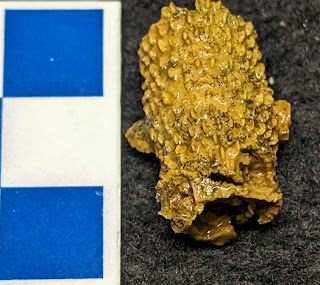This fragment of a crinoid calyx fossil pictured above is known as Dolatocrinus stellifer (Miller & Gurley, 1894). It was found in the Jeffersonville Limestone of the Falls of the Ohio, Clark County, Indiana USA. The fossil dates to the Devonian Period.
See a fossil of this species in 3-D at the University of Michigan web site: https://umorf.ummp.lsa.umich.edu/wp/specimen-data/?Model_ID=1459
This crinoid fossil was once part of the collection of southern Indiana paleontologist George K. Greene (1835-1917). It appeared that all of Greene's fossil collection was sold to American Museum of Natural History in New York City after his death but as it turns out there was one cabinet not sold and was past down to his descendants.
This fossil is now on display at the Falls of the Ohio State Park Interpretive Center till September 2024 after that it will be transferred to the Indiana State Museum. George Greene's great-great-grandson William "Bill" Bishop passed away on November 29, 2023 and his wish that fossils be donated.






































